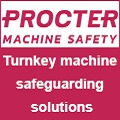
Posted to News on 21st Aug 2013, 11:18
Ladder safety for machine builders
There are plenty of ways in which serious ladder accidents can occur but there are also many preventative measures that you can take to avoid them, says ERIKS. Accidents involving falls from heights are by no means confined to the construction industry. In fact, the highest number of deaths occurs among those working at less than 2m off the ground. The Health and Safety Authority is therefore taking a far more aggressive stance in applying the Working at Height Regulations.
To meet these regulations and protect personnel it is important that employees take care to choose the right ladder for each job and use it safely. For example, when working with electricity - even when doing something as simple as changing a light bulb - a non-conductive fibreglass ladder is measurably safer than an aluminium ladder.
Having selected the right type of ladder for the task in hand, give a thought to its condition. Is the ladder safe to use? Are there any loose rungs? A moment spared to check on that state of your ladder could save a long stretch recovering from a fall.
A common cause of injury is a poorly positioned stepladder, and there must be many readers who have settled for a less than perfect positioning in haste to get the job done. Resist the temptation to do this. As with checking the ladder's condition, a moment's thought when positioning a ladder could prevent the long recovery period necessitated by a serious injury.
Another typical error of judgment is placing the steps sideways on to the wall when drilling a hole; as the worker applies force to push the drill bit into the wall, he or she is effectively pushing the steps over while standing on them.
So, make sure that (a) the right ladders are available for the work in hand, (b) they are correctly maintained, and (c) everyone has had the right training. This might involve consulting a distributor and manufacturer of ladders and access equipment, a measure that will not only ensure the right specification but also impress upon employees the importance of all the simple but crucial considerations discussed above.
Of course, once you have installed, checked and trained everyone in the use of the equipment, that is still not the end of the story. You need to establish on-going inspection and maintenance of the equipment. The recommended maintenance interval is 3 months for a ladder in daily use. This may surprise some readers, who would have perhaps marked this down as an item for annual inspection, but this interval should only be observed for equipment that is not used regularly.
Thorough inspection
Note also that this 3-monthly inspection should be much more in-depth than a simple pre-use check. A thorough inspection will need to include not only a check for loose rungs but also loose rivets, nuts and bolts, and for problems with rung locks on ladders or locking stays on steps.
An appropriate inspection should also be preventative and identify problems that may look likely to develop in the future, enabling personnel to plan repairs or replacements before they are urgently needed and an engineer is left with work to do and no safe means of doing it. And remember, preventative maintenance work is limited in its effectiveness unless documentation is maintained and stored safely.
It may be worth enlisting the services of an experienced partner to ensure you always have the right equipment for the job, as they may also be able to help specify and/or provide equipment for any particularly tricky working environments encountered by your operations. From an initial site visit to expert assessment, training in the use of equipment and servicing this may be the most efficient way of protecting staff and meeting regulations.
For further information about ladder safety for machine builders, email [email protected], or visit www.eriks.co.uk.

































